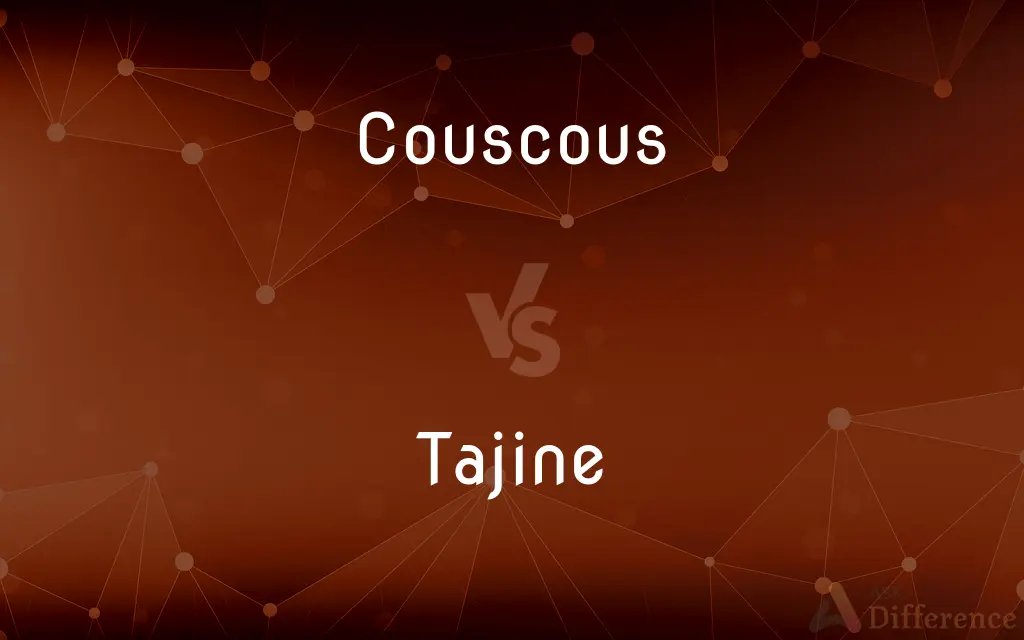Couscous vs. Tajine — What's the Difference?
Edited by Tayyaba Rehman — By Fiza Rafique — Updated on April 2, 2024
Couscous, a North African staple, is small steamed balls of crushed durum wheat semolina, versatile in dishes; Tajine, a Moroccan slow-cooked stew, is named after the earthenware pot it's cooked in, known for rich flavors.

Difference Between Couscous and Tajine
Table of Contents
ADVERTISEMENT
Key Differences
Couscous is a traditional North African dish made from small, steamed balls of crushed durum wheat semolina. It is celebrated for its versatility, serving as a base for both savory and sweet dishes, and can complement a wide array of ingredients like vegetables, meats, and spices. On the other hand, Tajine (or tagine) refers to both a Moroccan stew and the distinct conical earthenware pot in which it is cooked. The tajine pot is designed to circulate steam and return the condensed liquid to the pot, allowing food to cook slowly and retain moisture and flavor.
While couscous is primarily a grain, serving as a staple carbohydrate similar to rice or pasta in North African cuisines, tajine dishes are slow-cooked stews that may contain a variety of ingredients including meat, poultry, fish, vegetables, and fruits. Tajines often incorporate a rich blend of spices like cumin, coriander, cinnamon, and ginger, creating complex flavors and aromas, whereas couscous is typically flavored by the ingredients it is served with, rather than being heavily spiced itself.
Couscous is praised for its quick preparation time, often needing just a few minutes to steam over boiling water or broth, making it a convenient choice for a fast meal. Conversely, tajines are noted for their slow cooking process, which can take several hours, allowing for the deep integration of flavors and tenderization of meats. This slow cooking method is central to the dish's identity and appeal, emphasizing patience and the gradual melding of flavors.
In terms of serving, couscous is often a side dish or a base for more elaborate preparations, designed to soak up sauces and gravies from other dishes. Tajine, however, is typically a standalone dish that offers a hearty and complete meal, with its combination of protein, vegetables, and spices, often enjoyed with bread to scoop up the stew.
Couscous and tajine also reflect cultural significance and culinary traditions. Couscous is a staple food across North Africa and symbolizes hospitality and community. Tajine, with its unique cooking method and diverse ingredients, showcases Moroccan cuisine's complexity and the region's rich culinary history.
ADVERTISEMENT
Comparison Chart
Type
Grain-based staple
Slow-cooked stew
Origin
North Africa
Morocco
Ingredients
Durum wheat semolina
Variety of meats, vegetables, spices
Cooking Method
Steamed
Slow-cooked in a conical earthenware pot
Preparation Time
Quick (minutes)
Long (hours)
Serving
Side dish or base for sauces
Standalone meal
Flavors
Mild, adapts to accompanying flavors
Rich, with complex spice combinations
Cultural Significance
Symbol of hospitality and community
Represents Moroccan cuisine’s complexity and culinary history
Compare with Definitions
Couscous
Can be flavored with a variety of ingredients.
The couscous was flavored with herbs and spices for extra zest.
Tajine
The earthenware pot used for slow-cooking the stew.
The tajine was left to simmer on low heat for hours.
Couscous
Often used as a base for sauces and gravies.
The chicken gravy was served over a bed of fluffy couscous.
Tajine
A Moroccan stew made with meat, vegetables, and spices.
For the holiday, we prepared a lamb tajine with apricots and almonds.
Couscous
Symbolizes hospitality in North African cultures.
As a sign of hospitality, our hosts served us their traditional couscous.
Tajine
Reflects the complexity of Moroccan cuisine.
The variety of ingredients in the tajine showcases the diversity of Moroccan culinary traditions.
Couscous
Fine wheat pasta traditionally served with a meat or vegetable stew.
Couscous can be quickly prepared by steaming it over boiling water.
Tajine
Served as a complete meal, often with bread.
We enjoyed the chicken tajine as a hearty meal, using bread to scoop up the sauce.
Couscous
A North African dish of small steamed balls of semolina.
For dinner, we had couscous with lamb stew.
Tajine
Known for its rich blend of spices.
The tajine was aromatic with spices like cumin and cinnamon.
Couscous
Couscous is a North African dish of small (about 3 millimetres (0.12 in) in diameter) steamed balls of crushed durum wheat semolina that is traditionally served with a stew spooned on top. Pearl millet and sorghum, especially in the Sahel, and other cereals can be cooked in a similar way and the resulting dishes are also sometimes called couscous.
Tajine
A tajine or tagine is a Berber dish, named after the earthenware pot in which it is cooked. It is also called maraq or marqa.
Couscous
A pasta of North African origin made of semolina or other grains, formed into small pellets and usually steamed.
Tajine
(cookware) An earthenware cooking pot of North African origin, consisting of a shallow, round dish without handles and a tall, conical or dome-shaped lid.
Couscous
A North African dish consisting of this pasta served with stewed vegetables or meat.
Tajine
(by extension) A stew, originally from Morocco, the ingredients of which are traditionally cooked slowly in such a pot; the dish is normally served with couscous.
Couscous
A pasta of North African origin made of crushed and steamed semolina.
Couscous
A kind of food used by the natives of Western Africa, made of millet flour with flesh, and leaves of the baobab; - called also lalo.
Couscous
A spicy dish that originated in northern Africa; consists of pasta steamed with a meat and vegetable stew
Couscous
A pasta made in northern Africa of crushed and steamed semolina
Common Curiosities
Is couscous a main dish?
Couscous can be both a side dish and the base of a main dish, depending on the preparation.
Can couscous be served with tajine?
Yes, couscous can serve as a base for tajine, soaking up the stew's flavorful sauce.
What is couscous made of?
Couscous is made of small steamed balls of crushed durum wheat semolina.
How do you prepare couscous?
Couscous is prepared by steaming it over boiling water or broth until it becomes fluffy.
What are common ingredients in a tajine?
Common ingredients include meat, poultry, fish, vegetables, fruits, and a rich mix of spices.
How does the tajine pot affect the cooking process?
The tajine pot's design circulates steam and condenses liquid back into the stew, enhancing flavor and moisture retention.
What makes tajine unique?
Tajine is unique for its cooking method in a conical earthenware pot and its rich blend of spices and ingredients.
How long does it take to cook a tajine?
Cooking a tajine can take several hours, allowing for the flavors to meld and meat to become tender.
What type of meals is tajine suited for?
Tajine is suited for hearty meals, offering a complete dish with proteins, vegetables, and spices.
Is couscous healthy?
Couscous, being a grain, can be part of a healthy diet, especially when served with vegetables and lean protein.
Can tajine be made without the traditional pot?
While the traditional pot is preferred for authentic flavor, tajine dishes can be adapted for slow cookers or dutch ovens.
Is couscous gluten-free?
No, couscous is made from wheat and contains gluten.
Can vegetarian dishes be prepared as tajines?
Yes, vegetarian versions of tajine use a variety of vegetables and legumes, spiced and slow-cooked to perfection.
Share Your Discovery

Previous Comparison
Price vs. Prize
Next Comparison
Courage vs. CourageousAuthor Spotlight
Written by
Fiza RafiqueFiza Rafique is a skilled content writer at AskDifference.com, where she meticulously refines and enhances written pieces. Drawing from her vast editorial expertise, Fiza ensures clarity, accuracy, and precision in every article. Passionate about language, she continually seeks to elevate the quality of content for readers worldwide.
Edited by
Tayyaba RehmanTayyaba Rehman is a distinguished writer, currently serving as a primary contributor to askdifference.com. As a researcher in semantics and etymology, Tayyaba's passion for the complexity of languages and their distinctions has found a perfect home on the platform. Tayyaba delves into the intricacies of language, distinguishing between commonly confused words and phrases, thereby providing clarity for readers worldwide.
















































